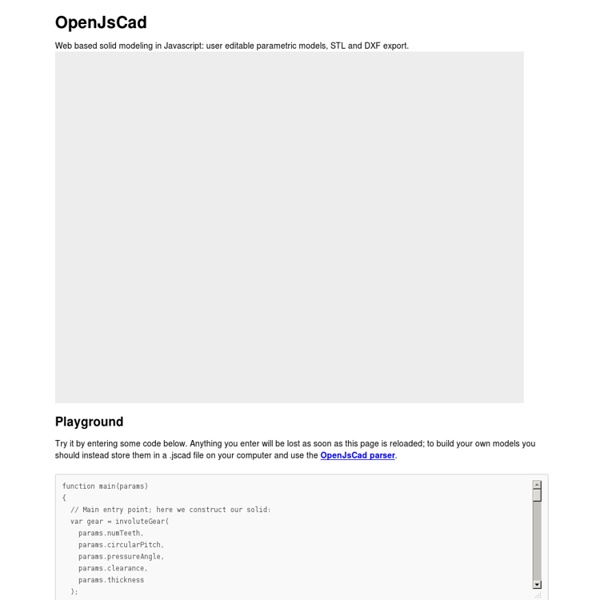I'm building a WebGL modelling tool for 3D printing
2 weeks ago Father Christmas delivered a MakerBot Thing-O-Matic 3D Printer to my office. I think I understand how it must have felt to own an Altair 8800 back in the day when the world was on the brink of the consumer computing revolution. Consumer 3D printing could be another such revolution. Expensive to very expensive professional products. Expensive to very expensive tools are tools like AutoCAD and Autodesk Inventor. Applications that have modelling capabilities but are aimed at rendering are those such as Blender , Maya and 3D Studio Max. I would puth Sketchup , OpenSCAD and 3D Tin into the "free but limited/difficult to use" category. (For a good overview of what 3D tools are available, have a look at "25 (Free) 3D Modelling Applications You Should Not Miss" or the list of tools listed on the ShapeWays website .) I was on a team that developed an advanced 3D modeller as part of an engineering tool suite earlier in my career, so I know what's possible. Accessible.
Shapesmith – An Open Source Web-based 3D Modeler
EmailShare 4EmailShare iPhone dock created in Shapesmith and printed on Thing-O-Matic How can I model the thing I want to print? As the population of 3D printer operators continues to grow, answering that question will become more important than ever. The developer, MakerBot operator, and Thingizen Benjamin Nortier tells us all about it. Q: Who are you and what is Shapesmith? I’m a software developer with an Engineering background and I’m also a 3D printing enthusiast. I wanted to design an Unmanned Aerial Vehicle (UAV) after being inspired by DIY Drones. Because I had worked on a 3D CAD tool for electromagnetic simulation earlier in my career, I was very dissatisfied by the free design tools that were available. Q: Why did you decide to open source it under the Apache license? Two of my favourite open-source projects, Riak and CouchDB, are licensed under Apache. Q: Your technology choices are interesting. And Javascript! Yes, and it’s great for everyone involved.
3D printing from Tinkercad
We’re delighted to announce that Tinkercad, a very easy-to-use CAD tool that runs in a browser (via WebGL), now offers a one-click support to our i.materialise 3D printing service. Thanks to this feature, getting an idea designed, printed, and in your hands is truly a piece of cake. Tinkercad is very user-friendly: with only three tools, a wide variety of designs can easily be made in Tinkercad in 5 minutes, or less. And remember, you can do all of this  in your browser with no installation required. Once your project is ready, simply click on the “Print 3D” button in the upper right-hand corner of the editor. Your design will be sent to the i.materialise 3D print lab, where you can choose from a variety of materials and colors. Add the design to your cart, place the order, and within a couple of days you will be showing off your design to everyone you know. Designing and 3D printing your own designs, like the connection piece pictured below has never been easier.
From cloud computing to personal fabrication
Surfing on the Internet this week I found Daniel Davis blog Digital Morphogenesis. I bumped into his last post HTML5 & WebGL where he introduces us to WebGL and its importance for CAD modeling. I am not an expert on these topics and Daniel’s article really helped me to understand what’s going on so I am going to share it with you. Using a browser that supports WebGL means that “users don’t need to download or install any additional plugins to view 3d content”. 3d models are now viewable on the Internet and we are able to generate a model, modify it and design it on the cloud. Daniel’s article points out some interesting examples of cad applications that we can find on the cloud computing context. CloudSCAD is now Open Source and available on GitHub. At CloudsCAD’s blog we have this video about personal production. FULL PRINTED from nueve ojos on Vimeo. We can find more information about personal production in this video-lecture Online Interactive Design and Customization at DHUB.
JNetCAD
JNetCAD ... ... the Java-Application for viewing and converting CAD data. JNetCAD is a simple Java GUI for importing and exporting several CAD formats. Each im- and export module exists as JAR library and can be used separately in other projects. JNetCAD uses jRealiy for the visualization. Hence it provides a software renderer and a JOGL (Java binding for OpenGL) renderer. Im- and exporter concept As mentioned above, the im- and export modules have been implemented as independend Java libraries, which can be used as loaders (for viewer, analyzer, ...) and conversion tools. Conversion example: JT -> JSON / CTM (WebGL) Here is an embedded example of the conversion from JT to JSON (WebGL). Screenshot (Firefox) Rotation: Left mouse button Translation: Right mouse button Scale: Wheel mouse button Click here for full screen with picking feature. Conversion example: JT -> 3D-PDF Licence All components can be used in non commercial or educational projects for free. Donation Downloads
verb - A CAD Library for the Web
ST-Developer - STEP Tools, Inc.
Since 1991, ST-Developer has been the most reliable, best performing, easiest to use, and most broadly supported SDK for STEP, STEP-NC, IFC, and related digital manufacturing standards! Add ST-Developer libraries to your software to read and write STEP CAD, CAM, and IFC BIM data, verify and view the results, ship your applications easily, and let our trained support staff guide you through the complexities of digital manufacturing data! Other features and recent additions include: STEP Faceting library that transforms STEP geometry into triangular meshes for display in an OpenGL, WebGL or other applications. Try before you buy with ST-Developer Personal Edition!



